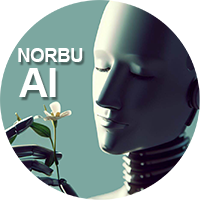Tibetan Buddhism: How it all began
The Star, April 23, 2007
Kuala Lumpur, Malaysia -- TIBETAN Buddhism began in the mid-7th century AD, when the powerful Tibetan king Songtsen Gampo (617-650AD) became a devout Buddhist under the influence of his two queens, Nepal’s Princess Birkurti and Princess Wencheng of China.
To propagate Buddhist teachings, the king sent his ministers to India to learn Sanskrit and Buddhism. Upon their return, they began translating sacred Buddhist texts from Sanskrit into Tibetan.
A century later, king Trisong Deutsan (742-797AD) invited a great Indian Buddhist master, Guru Padmasambhava (or the Lotus Born), to visit Tibet. The latter subdued the influences of the shamanistic Bonpo belief and, since then, Buddhism started to prosper.
The Drukpa (or Sky Dragons) lineage in Tibetan Buddhism has an 800-year legacy. It originated from the great enlightened Indian masters, Tilopa and Naropa. The lineage continued with Marpa, the Tibetan translator who travelled to India to receive Buddhist teachings and training.
The lineage’s beginning is associated with nine dragons soaring into the sky. Druk in Tibetan means dragon but it also refers to the sound of thunder. In 1206, Tsangpa Gyare Yeshe Dorje (then 45 years old) saw nine dragons flying up into the sky from the ground of Namdruk. He named his lineage Drukpa or Lineage of the Dragons, after this auspicious event. Thus, Tsangpa Gyare became the founder of the lineage and was known as the First Gyalwang Drukpa. All Gyalwang Drukpas are recognised and revered as reincarnations of Naropa.
Tsangpa Gyare was prophesised in many Buddhist texts and recognised as the indisputable emanation of Naropa (1016-1100). It was said that Buddha Shakyamuni spoke of the coming of Tsangpa Gyare.
He unveiled many treasures – holy teachings and objects – in southern Tibet, and also discovered Tsari, a holy place in Tibet.
Tsangpa Gyare became popular as Druk Tamchay Khyenpa, the Omniscient Dragon, and was addressed as Je Drukpa (Lord Dragon master) because of his spiritual attainments.
As many as 50,000 people were said to have attended his teaching sessions. He was also said to have 88,000 eminent followers, of whom 28,000 were enlightened yogis. His order became famous for the purity, simplicity and asceticism of its adherents and the profundity of its spiritual teachings.
Tsangpa Gyare was born in 1161 in the upper Nyang region of the Tsang province.
Soon after his birth, numerous spiritual masters recognised him as a reincarnation of a great saint and cared for him. He became accomplished in various Buddhist practices.
Under the guidance of his root master Lingchen Repa, he became an expert in Mahamudra (the Great Seal) meditation and the Six Practices of Naropa. He was able to withstand extremely harsh, cold weather.
In retreat in a snow-covered cave, Tsangpa Gyare only wore a thin, white, cotton robe. The psychic heat that his body generated melted away the snow under him as well as his surroundings.
When Tsangpa Gyare passed away at the age of 50, a rainbow canopy appeared; showers of flowers fell on the day of his cremation. It was said that many could hear celestial music and smell a beautiful scent in the air. When his body was cremated, his heart, tongue and eyes remained intact. His skull bore the images of Arya Avalokiteshvara (Guan Yin), Manjushri and Vajrapani; the 21 joints of his backbone turned into 21 mini statues of Avalokiteshvara. Many of these relics – proof of Tsangpa Gyare’s spiritual attainments – are still kept in various Drukpa monasteries.
Bhutan, one of the few remaining Buddhist kingdoms, takes the name of Druk or Druk Yul, meaning “the Land of the Thunder Dragons”. Its people are known as Drukpa. In the 17th century, Tsangpa Gyare’s fourth incarnation – Shabdrung Ngawang Namgyal (1594-1651) – united the warring regions in Bhutan and became the political and religious leader there.
The Himalayan Buddhist Kingdom of Ladakh, north India, is also an important stronghold of the Drukpa lineage.
Key events in celebrating 800 years of the Drukpa lineage will take place in:
# Ladakh, India, from July 13 to 24 (For more info, browse: ladakh.drukpa.com)
# Nangchen, China, from Aug 13 to 26 (For more info, browse: www.nangchen.org).

